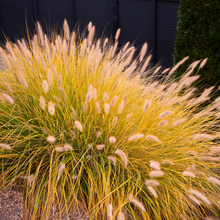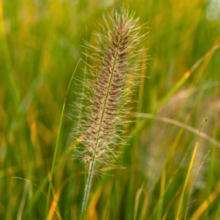Pennisetum alopecuroides 'Hameln', often called 'Hameln' fountain grass, is a well-liked ornamental grass known for its soft, plume-like flowers and compact growth. This Pennisetum cultivar features slender, arching green leaves that form a neat, rounded shape. It produces distinctive, silvery-white flower plumes towards the end of summer, which turn tan in the autumn. Its moderate size and elegant look make it a good choice for gardens, borders, and pots, adding a gentle, textured effect to various settings. It is part of the Poaceae family.
Origin: Pennisetum alopecuroides originates from East Asia and Australia. 'Hameln' is a widely grown cultivar, chosen for its compact form and plentiful blooms.
Light: Pennisetum alopecuroides 'Hameln' grows best in full sun. It needs at least six hours of direct sunlight each day for optimal growth and flowering.
Water: Water regularly during the first growing season to help it establish strong roots. After that, it can tolerate drier conditions. Allow the soil to dry slightly between waterings. Avoid overwatering, which can cause root problems.
Soil: Pennisetum alopecuroides 'Hameln' prefers soil that drains well. It can grow in various soil types, including sandy, loamy, and clay soils, as long as they drain properly.
Fertilising: This plant usually doesn't need much fertiliser. A light application of a balanced fertiliser in early spring can help it grow well. Avoid over-fertilising, which can lead to excessive leaf growth and fewer flowers.
Pruning: Cut back the foliage in late winter or early spring before new growth begins. This helps keep the plant looking tidy and encourages healthy new growth in the spring.
Division: Divide the plant every two to three years in early spring or autumn to keep it healthy and prevent it from becoming too crowded.
Pests and Diseases: Pennisetum alopecuroides 'Hameln' is generally resistant to pests and diseases.
Uses: Pennisetum alopecuroides 'Hameln' is mainly grown for its attractive leaves and feathery flowers. It's a popular choice for gardens, borders, pots, and natural-looking plantings.
Toxicity: Pennisetum alopecuroides 'Hameln' is generally considered safe for humans and pets.



